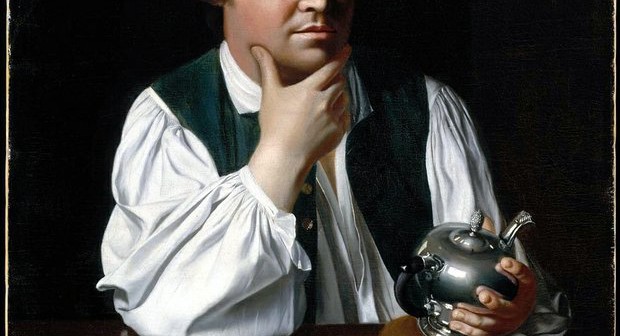While he’s most famous for his midnight ride, Paul Revere is also steeped in the tea culture of early America. It’s because of the tide of American history that we know him as a revolutionary; before the war, Revere was better known a successful silversmith whose teaware was of the highest quality. Today, about a dozen of his silver pieces reside at New York’s Metropolitan Museum of Art, providing sterling examples of how colonial-era America took its tea.
New York might be the greater trendsetter today, but at the time of the Founding Fathers, Boston was the hub of style and substance, and it was known for its trendy teaware. Among the more prominent Bostonian craftsmen was the Revere family, who enjoyed a particular reputation for making amazing silver teapots. And there was no shortage of tea to fill these pots, legally or otherwise. In fact, more than 75 percent of the tea consumed in America at the time was smuggled in from the Netherlands. The loose Dutch trade laws made them a key player in a booming transatlantic black market.
Wherever the tea came from, Revere was more than content to craft the wares his customers wanted. He was introduced to the silversmith trade by his father, the French Huguenot immigrant Apollos Rivoire (or “Paul Revere,” to use the Anglicized form he took upon immigrating). The younger Revere was delighted to start his apprenticeship at age 13—he hadn’t really liked his formal schooling, since rote exercises didn’t appeal to his creative nature. Instead, he applied his talents to uncovering the mysteries and potential of silver.
By adulthood, Revere had built a steady business crafting items such as teapots and salvers. For a time, he preferred working with the elegant simplicity of the popular Queen Anne style. In fact, the first known American teapot used this style. Eventually, teapots became more elaborate as colonial craftsmen incorporated the rococo style that was trendy in France. Regardless of the decorations used, traditional silver tea services featured a round shape—a globe, pear, or apple.
In December of 1773, all these stylistic concerns were tossed aside when 342 containers of tea were rapturously dumped into the frigid water by colonial protestors during The Boston Tea Party. Because of this event, tea and the course of American history would be forever intertwined.
In school, we all learned the tale about Boston colonials going berserk after the British raised the price of tea. But the true course of events is a very different tale. Despite having imposed various taxes on tea throughout the 1760s, at the time of the Tea Party, the British had just lowered the price of tea. The angry colonists were, in fact, black-market tea importers who stood to lose a lot of money over the price drop in British tea. Meanwhile, the wider population was aggravated not by the price of tea, but by the idea of being taxed by a monarchy they felt wasn’t considering or representing their best interests. Tea was just the scapegoat.
As tensions heightened between the British and the colonies, drinking tea became viewed as an unpatriotic act. In protest, many switched to coffee for their hot drink cravings. In the wake of the Boston Tea Party, demand for teapots plummeted. It appears that for about 10 years, Paul Revere didn’t make a single product related to tea, instead spending his time as a revolutionary. This includes making his famous ride only a year and a half after the Boston Tea Party. He did, however, emerge with a clever—albeit rather graphic—piece of revolutionary propaganda: an etching in which America is depicted as a half-naked woman, held down at the limbs and neck while tea is forced down her throat.
After all that nasty business with the British met its end, most Americans (including the patriots) tentatively rekindled their romance with tea. However, America’s passion for tea never quite returned to its former intensity—for better or worse, we became a nation of coffee drinkers. Still, tea had its place, and Paul Revere was happy to oblige with new and intriguing designs.
By the mid-1780s, Revere had returned to crafting teaware with a vengeance. At this point, a different style began to surface in his work. As related in Joel J. Miller’s book, The Revolutionary Paul Revere, the now-famous midnight rider had left behind the bulbous, round designs he learned from his father and ventured into crafting teapots with “squat cylinders” and “large wooden hoops for handles.” His teapots became drum-shaped or oval, instead of being apples or globes. These designs, already popular in Europe, were taking off in postwar America—which, despite now being an independent nation, was still heavily influenced by European trends. Revere, always looking for new ideas, was happy to experiment with these fashionable shapes.
Roughly thirty years after Revere’s death in 1818, silver deposits were discovered in Nevada. More silver created more opportunity for making specialized silver pieces, many of which were teapots, silver services, and other tea-related pieces. Given his flair for the dramatic and interest in pushing the boundaries of tea design, it’s easy to imagine that Revere might have preferred living in that era.
The colonial way of life would, however, see a renewal in the wake of the 1876 centennial celebration in Philadelphia. As part of this nostalgic return to all things colonial, tea drinking enjoyed a rise in popularity. And Revere’s works shined in the light of a rekindled fame.



